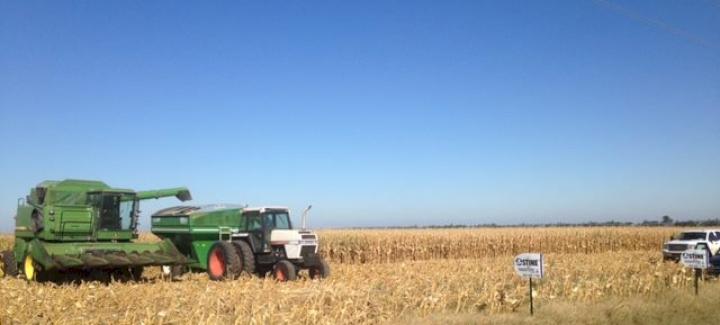
Region 2 — RSA Katie Lorenz
We’re about 90 percent done with corn harvest in Region 2, and things are coming out earlier than normal because of the dry weather. Yields have been above average, even with the long, wet spring, which surprised many growers this year.
Soybeans are pretty much done throughout the region. While a bit drier than normal, beans yielded well this year. LibertyLink® fields in particular are yielding through the roof. I’m seeing a lot of growers transitioning to LibertyLink to combat the glyphosate-resistant weeds we’re seeing up north.
Of the Stine HP Twin 20s in the region, growers are seeing about a 20 bushels per acre increase if the proper fertilizer was applied. There were some questions about harvestability of Twin 20s earlier this year, but growers were pleased to find the configuration came out with ease.
Region 3 — RSA Tony Lenz
Normally you would see all the beans come out first in Region 3, but because we did not get a frost, growers in the region went to corn while the beans dried up. That being said, many growers have mentioned that they’ve never seen this many bushels of beans, especially in southern Minnesota and Nebraska. Growers in southern South Dakota are also seeing some of the best beans they’ve ever had. Stine 19RF32 has been performing particularly well in southern Minnesota, and Stine 20RD20 has been really consistent across the board. Growers were also very happy with LibertyLink bean yields across all areas, especially with the weed control Liberty® herbicide provided.
Corn harvest is starting to wrap up in the region. Everything is really dry, and we’re seeing a lot of shelling. We’re finding that Stine R9424SS is performing really well in southwestern Minnesota and central South Dakota, and Stine R9732VT3PRO is doing well in northern Nebraska and southeastern South Dakota.
Region 4 — RSA Todd Schomburg
Soybean harvest is finished, and corn is probably close to 90–95 percent complete in Region 4.
HP corn products that have performed well this year are Stine R9631VT3PRO, R9740VT3PRO, R9733EVT3PRO and R9426VT3PRO. Most people that followed our protocol with sulfur, fungicide and sidedressing nitrogen are satisfied with HP corn, especially when planted under pivots where we’re seeing a 15–50 bushel increase by spoon-feeding nutrients.
As for soybeans, earlier beans are performing very well this year. Stine 23LF32 and 24LD00 are doing extremely well, and19LF62 is also performing well. Stine 20RD20 is also having another excellent year.
We’ve heard several northwestern Iowa growers say that they are seeing the best yields they’ve ever had on all corn and beans. We’re still compiling all of our plot data, looking at the new corn hybrids and soybean varieties to make sure that we make the best recommendations for our dealers and customers.
Region 11 — RSA Chuck Vaughan
Weather has been extremely dry and warm, which, on a positive note, has allowed farmers to keep going with harvest with no delays. The corn and beans have dried down very quickly this fall as a result, and although that’s great for cost savings for drying grain, you find out which products have good stalk quality.
For the most part, harvest is ahead of schedule, and our products are really shining in east central Illinois and northwestern Illinois. These areas had favorable growing conditions, and as a result, the products are showing it. Even in some less- than-favorable conditions, products really performed. One of our top-performing corn hybrids has been Stine R9635SS, which is winning almost every plot that it is in and has looked good coming out of the fields. Other top performers are Stine R9734VT3PRO, R9728EVT3PRO and R9529VT3PRO.
It was a great season for beans, especially with LibertyLink, which has been averaging in the 70s just about everywhere in Region 11, and in a few plots, we’ve seen it hit the 80s. Roundup Ready® 2 beans have also looked great with average to above average yields. The late 2s and early to mid 3s have looked the best. Conventional beans are, once again, having a great year with above-average yields in most cases. Stine 33E22 still seems to be the bean that rises to the top in east central Illinois.
Related Articles
-

Stine® to offer Syngenta’s Victrato® soybean seed treatment in 2026
December 2025 in Agronomy
-

Use Stine’s XP® seed treatments to prevent early injury to your crops
December 2025 in Agronomy
-

Understanding Stine’s enhanced oil profile soybeans
December 2025 in Agronomy
-

Soil sampling sets the stage for spring
November 2025 in Agronomy



